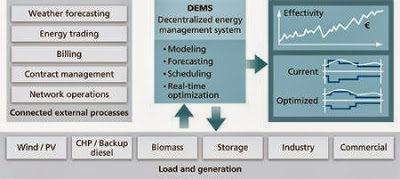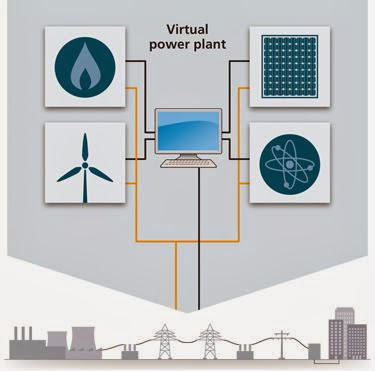Green Energy
Virtual Power Plants
One distributed generation technology with significant growth potential is the virtual power plant (VPP). In the VPP model an energy aggregator gathers a portfolio of smaller generators and operates them as a unified and flexible resource on the energy market or sells their power as system reserve.
VPPs are designed to maximize asset owners’ profits while also balancing the grid. They can match load fluctuations through forecasting, advance metering and computerized control, and can perform real-time optimization of energy resources.
“Virtual power plants essentially represent an ‘Internet of Energy,’ tapping existing grid networks to tailor electricity supply and demand services for a customer,” The VPP market will grow from less than US $1 billion per year in 2013 to $3.6 billion per year by 2020, according to Navigant’s research — and one reason is that with more variable renewables on the grid flexibility and demand response are becoming more crucial.
VPPs can deliver needed energy at peak usage times, and can store any surplus power, giving the energy aggregator more options than would exist in a single power plant. Other advantages include improved power network efficiency and security, cost and risk savings in transmission systems, increased value from existing infrastructure assets and reduced emissions from peaking power plants. And, importantly, VPPs can also enable more efficient integration of renewable energy sources into the grid by balancing their variability.
if one solar power source generates a bit more energy than predicted and another generates a bit less, they will compensate for each other, resulting in a more accurate forecast and making it easier to sell the capacity in the market or to use it in power systems operation. A VPP can also combine variable renewable power sources with stable, controllable sources such as biomass plants, using the flexibility of the biomass source to smooth out any discrepancy between planned and actual production.
How a VPP Works


A Virtual Power Plant aggregates different types of energy generation and controls it as if it was one source. Credit Siemens
source: RE world
- Part 3: Virtual Net Metering
By Kyra Hill, Energy Fellow In my last blog posts, I argued that due to its potentially far-reaching benefits, community solar should become an important component of a renewable energy-based electricity grid and identified some already existing models....
- Toshiba Dips Toes Into African Lava: New Geothermal Plant To Go Online In 2014
Toshiba has been tapped to supply equipment for Kenya’s newest geothermal power generation project. The company will supply geothermal steam turbines and generators early next year, which will go online in April 2014. Once the new power plant is active,...
- Roof Top Solar Power Net Metering Solution
Rooftop spaces and small areas around residential, commercial and Industrial buildings are high potential areas for Renewable power generation like Solar and Wind energy. Small quantities of power generated by each buildings or any other type of...
- Battery Energy Storage Project Shows Promise For Electricity Network
wth rising electricity prices one of the biggest issues facing households, Griffith University (Australia) research into energy storage and supply holds the promise of cheaper, better quality power for the low voltage (LV) electricity distribution network.Related...
- Government Aims To Build 36 New Solar Power Plants In 2013
Article published on www.thejakartaglobe.com on April 25, 2013The government is planning to build 36 new solar power plants across Indonesia, especially in isolated and border areas, an official said on Thursday.Alihudin Sitompul, the director...
Green Energy
A New Model for Solar Integration: Virtual Power Plants
Today’s global energy market is in the midst of a paradigm shift, from a model dominated by large centralized power plants owned by big utilities to a mixed bag of so-called distributed energy generation facilities — smaller residential, commercial and industrial power generation systems — many of which use renewable resources.
The boom in smaller installations, which are benefiting from new technological developments and business models, is undermining the traditional advantages associated with building large centralized power generation, such as economies of scale. For example, self-consumption, where consumers become producers of their own power (or “prosumers”), has caused major utilities to respond with new business models designed to keep those consumers as customers.Virtual Power Plants
One distributed generation technology with significant growth potential is the virtual power plant (VPP). In the VPP model an energy aggregator gathers a portfolio of smaller generators and operates them as a unified and flexible resource on the energy market or sells their power as system reserve.
VPPs are designed to maximize asset owners’ profits while also balancing the grid. They can match load fluctuations through forecasting, advance metering and computerized control, and can perform real-time optimization of energy resources.
“Virtual power plants essentially represent an ‘Internet of Energy,’ tapping existing grid networks to tailor electricity supply and demand services for a customer,” The VPP market will grow from less than US $1 billion per year in 2013 to $3.6 billion per year by 2020, according to Navigant’s research — and one reason is that with more variable renewables on the grid flexibility and demand response are becoming more crucial.
VPPs can deliver needed energy at peak usage times, and can store any surplus power, giving the energy aggregator more options than would exist in a single power plant. Other advantages include improved power network efficiency and security, cost and risk savings in transmission systems, increased value from existing infrastructure assets and reduced emissions from peaking power plants. And, importantly, VPPs can also enable more efficient integration of renewable energy sources into the grid by balancing their variability.
if one solar power source generates a bit more energy than predicted and another generates a bit less, they will compensate for each other, resulting in a more accurate forecast and making it easier to sell the capacity in the market or to use it in power systems operation. A VPP can also combine variable renewable power sources with stable, controllable sources such as biomass plants, using the flexibility of the biomass source to smooth out any discrepancy between planned and actual production.
How a VPP Works


A Virtual Power Plant aggregates different types of energy generation and controls it as if it was one source. Credit Siemens
source: RE world
- Part 3: Virtual Net Metering
By Kyra Hill, Energy Fellow In my last blog posts, I argued that due to its potentially far-reaching benefits, community solar should become an important component of a renewable energy-based electricity grid and identified some already existing models....
- Toshiba Dips Toes Into African Lava: New Geothermal Plant To Go Online In 2014
Toshiba has been tapped to supply equipment for Kenya’s newest geothermal power generation project. The company will supply geothermal steam turbines and generators early next year, which will go online in April 2014. Once the new power plant is active,...
- Roof Top Solar Power Net Metering Solution
Rooftop spaces and small areas around residential, commercial and Industrial buildings are high potential areas for Renewable power generation like Solar and Wind energy. Small quantities of power generated by each buildings or any other type of...
- Battery Energy Storage Project Shows Promise For Electricity Network
wth rising electricity prices one of the biggest issues facing households, Griffith University (Australia) research into energy storage and supply holds the promise of cheaper, better quality power for the low voltage (LV) electricity distribution network.Related...
- Government Aims To Build 36 New Solar Power Plants In 2013
Article published on www.thejakartaglobe.com on April 25, 2013The government is planning to build 36 new solar power plants across Indonesia, especially in isolated and border areas, an official said on Thursday.Alihudin Sitompul, the director...
